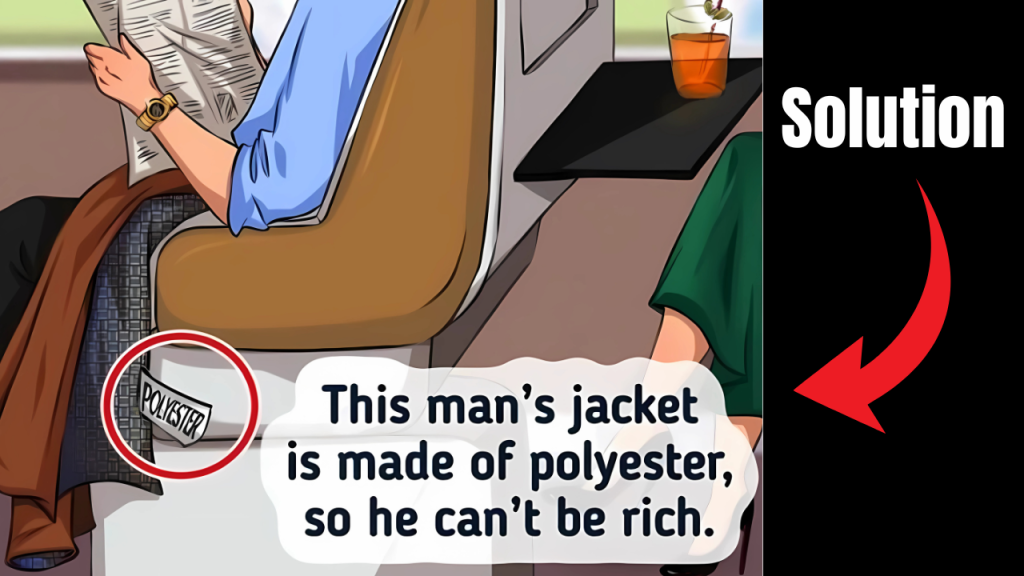Optical Illusion Picture this scenario: you’re sitting in an upscale café, surrounded by people flashing expensive watches and designer clothes. Everyone seems wealthy, but there’s a catch – only one person is genuinely rich. The rest are just pretending to be millionaires, putting on an elaborate show.
This fascinating brain teaser has been stumping people across the internet. The challenge seems simple enough: identify the real millionaire among a group of fake ones in just three seconds. But don’t let the simplicity fool you – this puzzle requires razor-sharp observation skills and lightning-fast thinking.
Most people who attempt this challenge walk away scratching their heads. The visual clues are subtle, and the time pressure makes everything more difficult than it appears.
What Makes This Puzzle So Tricky?
Brain teasers like this one tap into our natural tendency to make quick judgments based on appearance. We often associate wealth with flashy displays – expensive jewelry, designer clothing, and luxury accessories. However, this puzzle cleverly subverts those expectations.
Real millionaires often don’t dress to impress strangers in coffee shops. They might choose comfort over conspicuous consumption, wearing simple clothes while focusing on more important matters than public perception.
The fake millionaires in this scenario are doing exactly what most people would expect wealthy individuals to do. They’re showing off their supposed riches through obvious status symbols and attention-grabbing behaviors.
This creates a perfect storm of misdirection. Your brain wants to focus on the flashiest person, but the real answer lies in looking beyond surface-level appearances.

The Psychology Behind Wealth Perception
Understanding how we perceive wealth can help crack this puzzle faster. Most people have been conditioned by movies, social media, and advertising to associate money with specific visual markers.
Designer handbags, expensive watches, and flashy jewelry become mental shortcuts for identifying wealthy individuals. However, research shows that truly wealthy people often avoid these obvious displays of wealth.
Many millionaires prefer stealth wealth – looking ordinary while building their fortunes quietly. This phenomenon explains why the puzzle works so effectively at fooling people.
The challenge forces you to override your preconceived notions about how rich people should look. Success requires ignoring the obvious distractions and focusing on more subtle behavioral cues.
Your brain needs to process multiple pieces of information simultaneously while fighting against its natural inclinations. That’s what makes this three-second time limit so brutally challenging.
Spotting the Real Clues
So what should you actually look for when trying to identify the genuine millionaire? The key lies in understanding authentic wealthy behavior versus performative displays of status.
Real millionaires often exhibit confidence without needing external validation. They don’t feel compelled to prove their wealth to strangers in public spaces. This confidence shows up in their body language and facial expressions.
Look for someone who appears relaxed and comfortable without trying to impress anyone. They might be dressed well but not ostentatiously. Their focus is likely on something other than showing off to the people around them.
Fake millionaires, on the other hand, tend to overcompensate. They make sure their expensive items are visible and positioned to catch attention. Their behavior often seems forced or calculated rather than natural.
The genuine millionaire in this puzzle typically sits quietly, perhaps enjoying their coffee while reading or thinking. They don’t need to announce their presence or wealth to the room.
Optical Illusion Answer

The Science of Quick Decision Making
Three seconds might not seem like much time, but your brain can process an incredible amount of information in those brief moments. Understanding how rapid cognition works can improve your puzzle-solving abilities.
During the first second, your eyes automatically scan the entire image, gathering basic visual information about each person. Your brain starts forming initial impressions based on clothing, posture, and obvious accessories.
The second second involves deeper processing, where your mind begins analyzing facial expressions, body language, and the subtle details that separate authentic behavior from performed behavior. This is where most people get tricked by obvious distractions.
The final second is crucial for making your decision. Your brain must overcome its initial biases and focus on the person who doesn’t fit the stereotypical wealthy person mold.
Successful puzzle solvers learn to trust their instincts about authentic human behavior rather than getting distracted by shiny objects and designer labels.
Training Your Observation Skills
Regular practice with visual puzzles can dramatically improve your ability to spot important details quickly. Like any skill, observation gets better with deliberate practice and focused attention.
Start by examining photographs of groups and trying to identify who might be the leader, the outsider, or the person with a secret. Look beyond obvious visual cues and focus on micro-expressions and body positioning.
Practice scanning images systematically rather than randomly jumping around. Develop a method for quickly assessing each person in a group photo, noting both obvious and subtle characteristics.
Pay attention to inconsistencies between someone’s appearance and their behavior. Often, the most important clues are found in these subtle contradictions.
Challenge yourself with similar puzzles regularly, gradually reducing the time you allow for making decisions. This builds the mental speed needed for rapid-fire brain teasers.
Why This Type of Puzzle Matters
Beyond entertainment value, these observation challenges serve important purposes in developing critical thinking skills. They teach us to look beyond surface appearances and question our initial assumptions.
In real life, the ability to read people accurately can be incredibly valuable. Whether you’re networking at business events, interviewing job candidates, or simply trying to understand the people around you, social observation skills matter.
These puzzles also highlight how easily our brains can be fooled by preconceived notions. Recognizing these cognitive biases helps us make better decisions in situations that actually matter.
Professional detectives, security personnel, and investigators regularly use similar observation techniques in their work. They learn to spot the person who doesn’t belong or whose behavior seems inconsistent with their stated purpose.
The entertainment industry has also embraced these concepts, creating countless shows and movies about characters who can instantly read people and situations. While these portrayals are often exaggerated, they’re based on real psychological principles.
Common Mistakes People Make
Most failed attempts at this puzzle follow predictable patterns. Understanding these common errors can help you avoid them in future challenges.
The biggest mistake is focusing too heavily on expensive accessories. While these items catch the eye immediately, they’re often red herrings designed to distract from the real answer.
Another frequent error involves overthinking the time pressure. Some people spend too much time analyzing one person instead of quickly scanning all the options. The three-second limit forces rapid assessment, not detailed analysis.
Many people also get stuck on their first impression. Once they identify someone as “looking wealthy,” they have trouble considering alternatives. Successful puzzle solvers remain flexible in their thinking.
Some individuals try to apply complex psychological theories instead of trusting their basic observation skills. Sometimes the simplest answer – the person who looks most natural and relaxed – is correct.
Finally, cultural biases about wealth and status can interfere with accurate assessment. Different backgrounds lead to different expectations about how wealthy people should behave and dress.
The Solution and What It Reveals
In the classic version of this puzzle, the real millionaire turns out to be the quietly dressed person sitting in the corner, often reading or simply enjoying their beverage. While others flash expensive watches and designer bags, the genuine wealthy individual needs no such validation.
This solution perfectly illustrates the concept of authentic confidence versus performed status. The real millionaire is comfortable enough with their position that they don’t need to prove anything to strangers.
If you spotted this person within three seconds, congratulations! Your observation skills are exceptionally sharp, and you demonstrate the ability to see beyond obvious distractions to identify authentic behavior patterns.
Those who took longer shouldn’t feel discouraged. These puzzles are designed to be challenging, and improving your performance takes practice and awareness of common pitfalls.
The most important lesson isn’t about speed – it’s about developing the ability to question your assumptions and look for authentic human behavior rather than performed displays.
Building Your Puzzle-Solving Skills
Want to get better at these types of challenges? Start by observing people in real-world settings like coffee shops, airports, or shopping centers. Practice identifying who seems genuinely confident versus who appears to be trying too hard.
Read books about body language and micro-expressions to understand the subtle signals people send through their posture, facial expressions, and gestures. This knowledge translates directly to puzzle-solving success.
Challenge yourself with related brain teasers that require quick observation and decision-making. Look for puzzles involving spotting the odd person out, identifying the leader in a group, or finding the person who doesn’t belong.
Time yourself regularly to build speed without sacrificing accuracy. Start with longer time limits and gradually reduce them as your skills improve.
Most importantly, learn to trust your instincts about people while remaining open to being wrong. The best puzzle solvers combine quick intuition with the flexibility to reconsider their initial assessments.
The Broader Impact of Visual Puzzles
These brain teasers represent more than just entertainment – they’re powerful tools for developing crucial life skills. The ability to quickly assess situations and people accurately has applications far beyond puzzle-solving.
In professional settings, these skills help with reading clients, understanding team dynamics, and identifying potential problems before they escalate. Leaders who can quickly assess group dynamics make better decisions and communicate more effectively.
Parents can use these observation skills to better understand their children’s needs and emotional states. Teachers benefit from being able to quickly identify which students are struggling or disengaged.
Even in casual social situations, the ability to read people accurately leads to better relationships and more successful interactions. You become better at identifying genuine versus superficial connections.
The confidence that comes from trusting your observational abilities also improves decision-making in high-pressure situations. You learn to rely on pattern recognition and intuitive assessment rather than being paralyzed by overthinking.
Creating Your Own Challenges
Once you’ve mastered the millionaire puzzle, try creating similar challenges for friends and family. Set up scenarios where one person doesn’t fit the expected pattern and see if others can spot the difference quickly.
Take group photos at parties or gatherings and create puzzles about who has a specific trait or background. This adds an educational element to social events while developing everyone’s observation skills.
Use movie scenes or historical photographs to create identification challenges. Ask viewers to spot the person who might be the leader, the outsider, or the one with a secret agenda.
Social media provides endless opportunities for practicing these skills. Look at group photos and try to identify interesting patterns or anomalies before reading the captions or comments.
Remember that the goal isn’t just speed – it’s developing the ability to notice important details that others might miss. This skill proves valuable in countless real-world situations.
Mental Agility
The fake millionaire puzzle perfectly demonstrates how our brains can be both incredibly sophisticated and surprisingly predictable. We excel at rapid pattern recognition but struggle when those patterns don’t match our expectations.
Success with these challenges requires balancing quick thinking with careful observation. You need to trust your instincts while remaining open to surprising answers that contradict obvious assumptions.
Regular practice with visual puzzles and observation exercises keeps your mind sharp and improves your ability to navigate complex social and professional situations. These skills become more valuable as our world becomes increasingly fast-paced and complex.
Whether you solved the puzzle in three seconds or needed more time, the important thing is engaging with challenges that push your mental boundaries. Every attempt builds neural pathways that improve future performance.
Keep practicing, stay curious about human behavior, and remember that the most obvious answer isn’t always correct. Sometimes the real treasure is hidden in plain sight, waiting for someone with the right combination of speed and insight to discover it.
Frequently Asked Questions
What makes someone look like a “fake” millionaire? Fake millionaires typically overcompensate with obvious status symbols, forced displays of wealth, and attention-seeking behavior that seems calculated rather than natural.
How can I improve my observation skills for these puzzles? Practice regularly with similar challenges, study body language, observe people in real settings, and learn to trust your instincts about authentic versus performed behavior.
Why do real millionaires often dress down? Genuine wealthy individuals often prefer comfort and practicality over flashy displays, as they don’t need external validation of their success and may want to avoid unwanted attention.
Is three seconds really enough time to solve this puzzle? Yes, your brain can process enormous amounts of visual information in three seconds, though success requires training your attention to focus on the right details quickly.
What cognitive skills does this puzzle test? This challenge tests rapid visual processing, pattern recognition, social observation abilities, decision-making under pressure, and the ability to overcome cognitive biases.
Can these puzzles help in real-life situations? Absolutely! The observation skills developed through these puzzles apply to reading people in professional settings, understanding social dynamics, and making better interpersonal decisions.
Why do most people fail this type of puzzle? People typically fail because they focus on obvious distractions like expensive accessories instead of authentic behavioral cues, and they struggle to overcome preconceived notions about wealth.
Are there different versions of this puzzle? Yes, many variations exist with different settings and scenarios, but they all test the same core skill of identifying authentic versus performed behavior patterns.
How does time pressure affect puzzle performance? Time pressure forces rapid assessment and prevents overthinking, but it can also cause people to rush and miss important subtle details that reveal the correct answer.
What’s the most important tip for solving these puzzles? Look for the person who appears most naturally confident and relaxed, rather than focusing on expensive accessories or attention-seeking behavior that might be fake displays of wealth.
